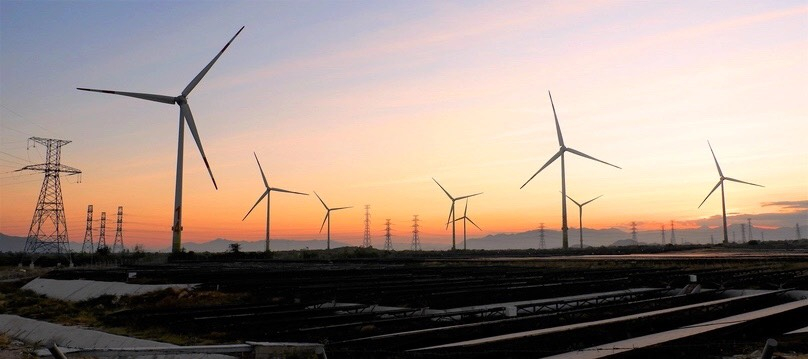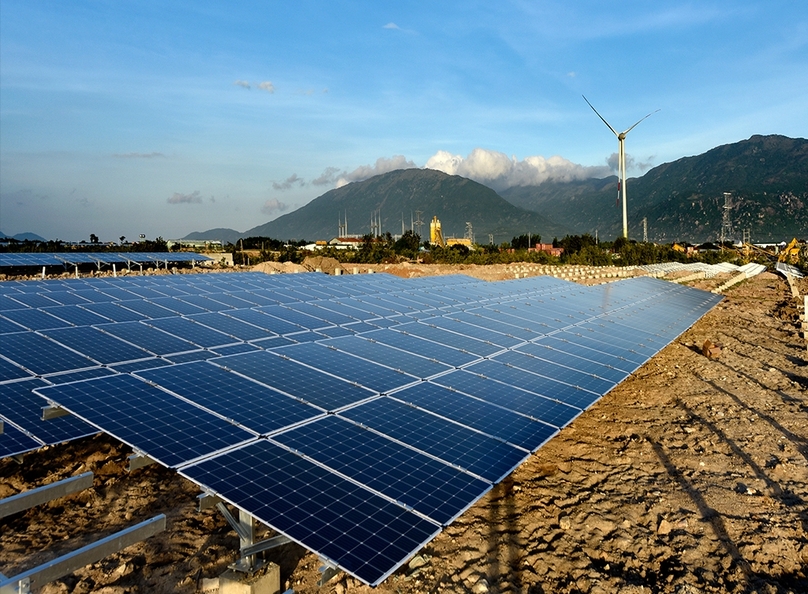Global energy majors stoke Vietnam renewables market
Vietnam has become a hot spot on the global renewables map as major developers rush to its fast-developing and power-thirsty economy, which is looking to net-zero carbon emissions by 2050.
With vast coastal areas suitable for offshore wind development, a strong national commitment to renewables, a population approaching 100 million, and substantial, ever-increasing energy needs, Vietnam is fertile ground for renewable energy development.
The World Bank said "the Southeast Asian nation is seen as one of the world’s most energy-thirsty economies," and "Vietnam consumes more energy per unit of economic output than the Philippines, Malaysia, Indonesia, and India."
Active Asian investors
AC Energy, part of the Philippines’s Ayala Corporation, is researching a fresh investment of $6 billion for a major wind power project in Vietnam, where it switched on three wind farms last year to add 380 megawatts to the national grid.
AC Energy continues to leverage Vietnam’s strong wind resource potential with such mammoth capital in the pipeline for 2,400 MW of offshore wind in the central province of Quang Binh, said Nguyen Nam Thang, CEO of AMI AC Renewables, a joint venture between AC Energy and Vietnamese company AMI Renewables.
The three wind farms the Ayala energy platform turned on last year made Vietnam its largest market to date outside the Philippines. The largest of the three is the 252 MW Quang Binh wind farm, developed by AMI AC Renewables and beginning commercial operations last October after 13 months’ construction.
"The smooth development despite several Covid-19 pandemic outbreaks in Vietnam, together with provincial full support, is behind the joint venture’s decision to go ahead with the new wind farm with that much investment," Thang told a Quang Binh investment promotion conference in Ho Chi Minh City late this March.
Smooth development despite several Covid-19 outbreaks in Vietnam, together with full provincial support lie behind the joint venture’s decision to commence with the new wind farm utilizing that much investment, he added.
Also, last October, AC Energy and partner The Blue Circle switched on the 40 MW Mui Ne phase 2 wind farm in Binh Thuan province, more than 200 kilometers north of HCMC. In Ninh Thuan province, which borders Binh Thuan to the north, the Filipino firm and partner BIM Group commenced operations of the 88 MW Ninh Thuan wind farm as their second partnership in the country.
Of AC Energy’s six renewable energy projects in Vietnam, five are operational while the 60 MW Lac Hoa and Hoa Dong wind power project in Soc Trang province in the south is set to come online later this year. It is a collaboration with American wind and solar farm developer UPC Renewables.
AC Energy says it is now in the process of spending $165 million to acquire a 49% interest in Thai-invested power company Solar NT in Vietnam.

A solar and wind power farm in Ninh Thuan province, south central Vietnam. Photo by The Investor/Tuong Thuy.
Vietnam’s latest draft power development plan VIII (PDP VIII) sets out a new scenario for wind power and other renewable energy sources by 2030. This includes reaching 17 gigawatts of onshore and 7 GW of offshore wind power.
The Global Wind Energy Council (GWEC), an international trade group for wind power, believes Vietnam can achieve a target of 5-10 GW by 2030. For the 2030 – 2045 period, the target of onshore wind power installation is 38 GW, equivalent to 1.4 GW/year.
HCMC-based Bamboo Capital Group (BCG) has recently emerged as a strong developer in the country. It is partnering with SP Group, a major in Asia-Pacific, to develop 500 MW of rooftop solar power in Vietnam. Last December, BCG Energy signed a deal with Sembcorp Utilities, a member of Singapore’s Sembcorp Industries, to develop renewable energy projects of up to 1.5 GW in the country.
A month prior, international wind turbine maker Siemens Gamesa Renewable Energy signed a memorandum of understanding (MoU) to provide BCG Energy with equipment and technical solutions worth $400 million.
Pham Minh Tuan, Vice Chairman of BCG and CEO of BCG Energy, said he believed Vietnam has a foundation to achieve its net-zero target, and this government commitment has unlocked global financial resources to provide opportunities for Vietnam to develop.
As for Sembcorp Industries, the Singaporean major signed four agreements in February to support Vietnam’s energy transition and sustainable development.
"Sembcorp will develop a range of energy and urban development solutions in industrial parks, power systems, renewable energy and technology, and skills and capabilities building," the company said in a release.
Sembcorp provides sustainable solutions such as micro-grid-integrated solar and battery storage, wastewater recovery, and electric vehicle charging infrastructure. Under the second agreement, Sembcorp will team up with state-owned Vietnam Electricity to fuel the country’s green sustainable development and economic growth.
In February, SK Group, South Korea’s third-largest chaebol, rolled out a $200 million joint venture to develop 250 MW of rooftop solar projects in energy-thirsty Vietnam. Saturn Solar Energy, based in HCMC, is a 51:49 joint venture between SK Ecoplant and Nami Solar of Vietnamese firm Nami Energy.
In the partnership, the Korean side will be responsible for the registration, issuance, conversion, and sale of carbon emission rights, while the domestic side deals with business development, licensing, power purchase agreements, and engineering, procurement and construction work.
The venture’s first project is a 65 MW rooftop system at Sonadezi Industrial Zone in Dong Nai province next to HCMC. Operation is scheduled to start this June.
Saturn Solar Energy expected to complete 60-65 MW in installed capacity each year to reach its 250 MW target in four years. The projects will serve both Vietnamese and foreign businesses, including Korean firms seeking green energy and lower energy costs.
The partnership has secured its first project to install and operate 2.5 Megawatt-peak (MWp) for a CJ Vina Agri Co. manufacturing plant by this June.
Meanwhile, SP Group, in addition to its partnership with BCG, launched in March this year another partnership with CJ OliveNetworks Vina Co. of Korean conglomerate CJ Group to co-develop rooftop solar projects in Vietnam, with 50 Megawatt-peak (MWp) expected for the next two years. The partnership has secured its first project to install and operate 2.5 MWp for a CJ Vina Agri Co. manufacturing plant by this June.
Jang Myung Soo, CEO of CJ OliveNetworks Vina, said SP's sustainable energy solutions would be pivotal in enhancing energy-efficient operations across all sectors and scales.
“We look forward to collaborating with SP to accelerate the renewable energy sector and meet the growing demand in the industry by leveraging upon our combined strengths, networks, and expertise,” Soo said.
European, U.S. footprint
Notably, Madrid-headquartered EDPR, the world’s fourth-largest renewable energy producer, plans to invest up to about $7.34 billion by 2030 to establish a leading clean energy hub in Singapore for investments in Asia-Pacific. The move followed the European major’s $813 million acquisition of Singapore-based clean energy solutions provider Sunseap, which has established its Vietnam footprint via a $150 million solar farm in Ninh Thuan province. The project was commissioned in 2019 with a size of 168 MWp.
Part of EDPR’s huge, planned Asia-Pacific investments is expected reach to Vietnam, among that of other European developers.

Trung Nam Wind Farm in Ninh Thuan province, owned and developed by HCMC-based Trung Nam Group. Photo by The Investor/Tuong Thuy.
France’s EDF Renewables and VinaCapital Group, one of Vietnam’s leading investment management companies, last October launched a partnership with plans to invest more than $100 million between 2022 and 2024 in the Vietnamese renewables market.
VinaCapital, based in HCMC and with over $3.7 billion in assets under management, said the new partnership would back its SkyX Solar company to further develop rooftop solar and energy distribution projects for commercial and industrial customers with 200 MWp.
“The launch of SkyX Solar in 2019 is just one of our initiatives in the sector. In a very short span of time, it has grown to become a leading player in the commercial and industrial rooftop solar market in the country. We look forward to working with EDF Renewables to help SkyX Solar grow as well as exploring other projects where there are synergies,” Don Lam, Co-Founder and CEO of VinaCapital, said while commenting on the partnership last October.
In early 2021, France's EDF Renewables, with more than VND2,210 billion ($98 million) in investment, secured a deal to develop two wind power plants in the Central Highlands province of Dak Lak with a total capacity of 70 MW. The firm aims to produce a total 50 GW of renewable energy by 2030 for global markets and considers Vietnam one of its strategic markets in Asia.
American company UPC Renewables last September signed an MoU with Vietnamese conglomerate T&T Group to jointly develop onshore and nearshore wind farms and solar power projects in Vietnam, with total investment estimated at $2.5 billion.
Just prior, Hanoi-based T&T signed another MoU with Denmark-headquartered Ørsted, a global leader in offshore wind, to launch a wind energy partnership with collaboration investment periods planned for 20 years.
The Danish-Vietnamese partnership expected to generate almost 10 GW from their offshore wind projects located off the coasts of the central provinces of Binh Thuan and Ninh Thuan, Vietnam’s most suitable areas for offshore wind development. Investments of up to $30 billion are estimated for the ambition.
"In addition to a number of large solar and wind power projects that have been and are about to be completed, T&T Group also plans to develop strategies for renewable energy, gas power, port and LNG gas center projects up to 2030 and a vision to 2045," T&T Chairman Do Quang Hien commented on the partnership with Ørsted.
"The cooperation with a leading corporation in offshore wind like Ørsted will help T&T accelerate the implementation of the above plan, as well as give us valuable experience and international investment to the offshore wind sector in Vietnam," he added.
Matthias Bausenwein, President of Ørsted Asia Pacific, said at that time that Ørsted targeted 30 GW of offshore wind by 2030. “To support the ambition, we need to work closely with partners like T&T Group - an enterprise with an impressive track record in developing large energy projects in Vietnam and giving us insight about this market."
T&T switched on four solar power plants with a combined installed capacity of 245 MW in 2020 and commissioned 530 MW of onshore wind projects last year. For the next 10 years, it plans to develop energy projects across liquefied natural gas (LNG) and renewables with an estimated total capacity of 10 GW to 11 GW.
This April, British power firm Shire Oak International and Vietnam’s Vu Phong Energy Group JSC signed a deal to develop rooftop solar power systems at Vietnamese factories run by South Korea’s Hwaseung Enterprise Co. Ltd. The project, with a total capacity of over 12.5 MW, will receive $10 million in total investment and be implemented following the build- lease-transfer format.





